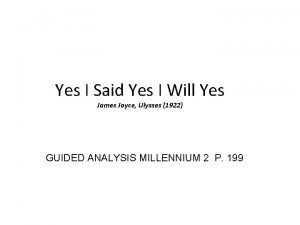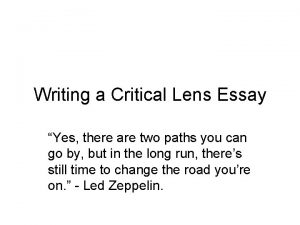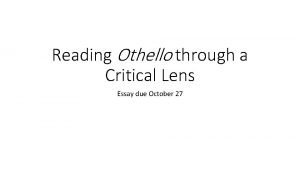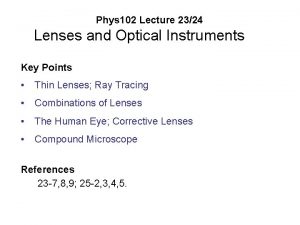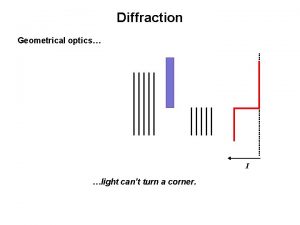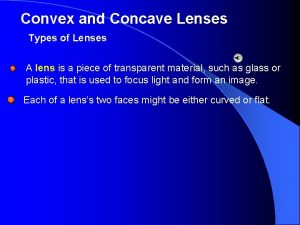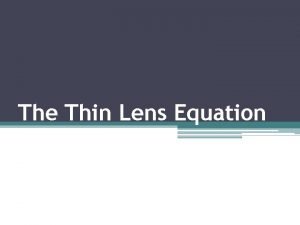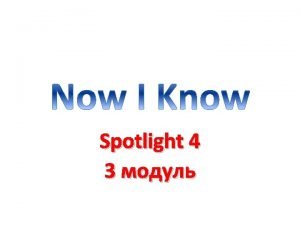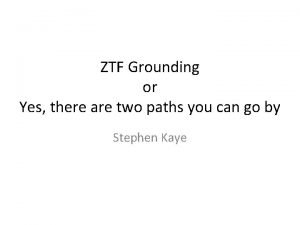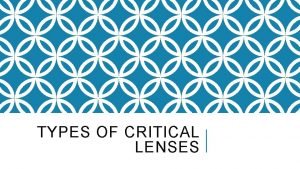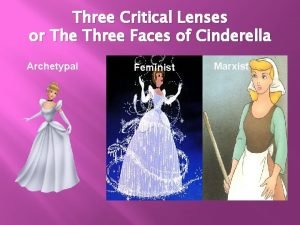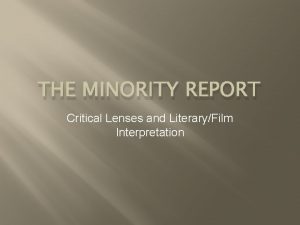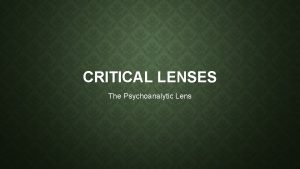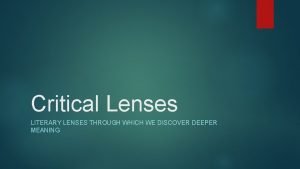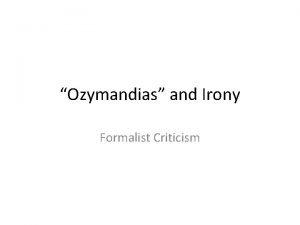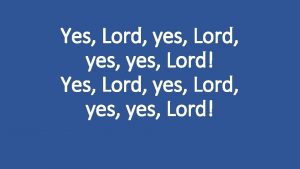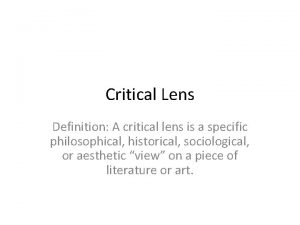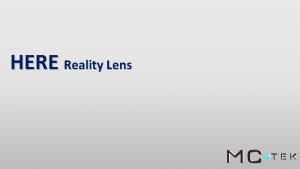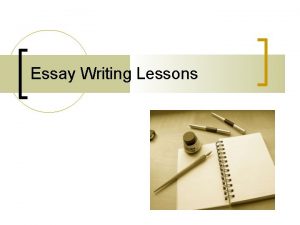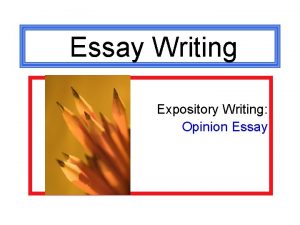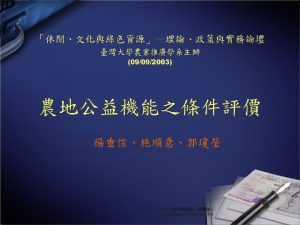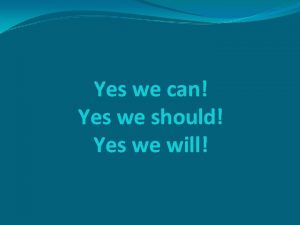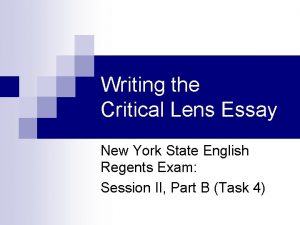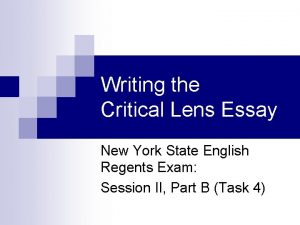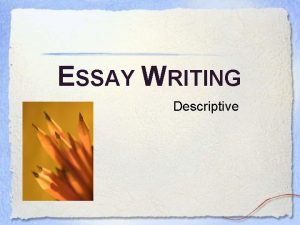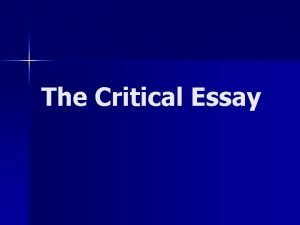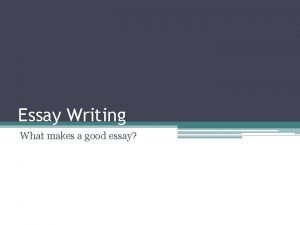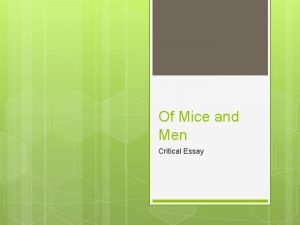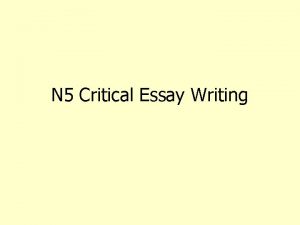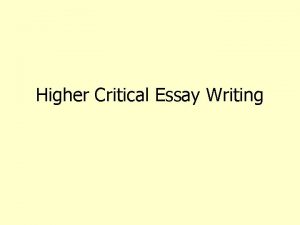Writing a Critical Lens Essay Yes there are






















- Slides: 22

Writing a Critical Lens Essay “Yes, there are two paths you can go by, but in the long run, there’s still time to change the road you’re on. ” - Led Zeppelin.

Your Task: Write a critical essay in which you discuss two works of literature you have read from the particular perspective of the statement that is provided for you in the Critical Lens. In your essay, provide a valid interpretation of the statement, agree or disagree with the statement as you have interpreted it, and support your opinion using specific references to appropriate literary terms from the works.

Literary Elements/Devices • CHARACTERIZATION the various means an author uses to describe and develop characters (direct/indirect) • CONFLICT a confrontation or struggle between opposing forces (Man v. Man ; Man v. Self ; Man v. Nature ; Man v. Society) • FIGURATIVE LANGUAGE descriptions that associate or compare distinct things (simile ; metaphor ; alliteration ; personification ; hyperbole) • FLASHBACK a scene that interrupts the present action to depict some earlier event

Literary Elements/Devices • FORESHADOWING an author’s use of hints or clues to suggest events that will occur later in a story • IMAGERY the use of language to convey a visual picture or represent a sensory experience • • IRONY a contradiction between what is expected (or what appears to be) and what actually happens • PLOT the sequence of events in a literary work exposition –rising action –climax –falling action resolution

Literary Elements/Devices • POINT OF VIEW the perspective from which a narrative is told – first-person “I” ; third-person (omniscient/limited) • SETTING the time and place of the action in a literary work • SYMBOLISM anything that stands for or represents something else • THEME the central messages revealed through a literary work • TONE the writer’s attitude toward his or her audience and subject

Sample Critical Lens Quote • Critical Lens: – “To gain that which is worth having, it may be necessary to lose everything else. ” • —Bernadette Devlin • The Price of My Soul, 1969

Critical Lens: Essay Structure • Introduction • Body Paragraph 1 –Literary Work 1 –Literary Element 1 • Body Paragraph 2 –Literary Work 2 –Literary Element 2 • Conclusion

Introduction FOUR STEPS: 1. Introduce/State Quote 2. Interpret Quote 3. Introduce text(s): Give the titles and authors of the literary work you will discuss. 4. Thesis/Claim: Agree with the Quote (This quote is true to life and literature)

Introduction STEP ONE: 1. State Quote Bernadette Devlin once said, “To gain that which is worth having, it may be necessary to lose everything else. ”

Introduction STEP TWO: 2. Interpret Quote This quotation means that it is sometimes necessary to give up what we have in order to attain something even greater.

Introduction Introduce the texts: 3. Both (title of literary work 1) by (author of literary work 1) and (title of literary work 2) by (author of literary work 2) support the idea that some things worth having cannot be gained without sacrifice

Introduction STEP FOUR: 4. Thesis/claim Agree with the quote “This quotation holds true in both life and in literature. ”.

Introduction – Put it all together • Bernadette Devlin once said, “To gain that which is worth having, it may be necessary to lose everything else. ” This quotation means that it is sometimes necessary to give up what we have in order to attain something greater. Both “The Necklace” by Guy de Maupassant and “The Last Leaf” by O. Henry support the idea that some things worth having cannot be gained without sacrifice. This quotation holds true in life and in literature.

Body Paragraphs FIVE STEPS: 1. Topic sentence –The novel/story____ shows that ____. 2. Transition statement/literary element “ –One way (author/work) proves this point is through (the theme and moral) 3. Identify theme and moral 4. Connect lens/quote and literary element (Give relevant supporting details from the text) 5. Concluding sentence

Today’s Challenge • When writing about literature, which literary element do you believe is the most important to focus on? • Theme: It is the message about life and human nature that the author intends for you to acknowledge. It is why the author writes his/her story.

Body Paragraph STEP ONE: 1. Topic Sentence The novel (title of literary work) demonstrates that in order to gain that which we truly desire, we must sometimes give up all that we have.

Body Paragraph STEPS TWO & THREE: 2. Transition statement/literary element 3. Define literary element One way this work proves this point is through theme. Theme is the central messages revealed through a literary work.

Body Paragraph STEP FOUR: 4. Connect lens and literary element Provide and explain TWO examples from the novel/story that support the quote using the literary device you have selected.

Body Paragraph STEP FIVE: 5. Concluding Sentence Write a concluding sentence that ties your paragraph’s main idea back to your thesis.

Sample Body Paragraph: Put it all together! The short story, “The Last Leaf, ” shows a character sacrificing his life for another. This reveals theme that sometimes one person must make a sacrifice in order to save another. One way this story proves this point is through theme. Theme is the central messages revealed through a literary work. Mr. Behrman is a minor character who is initially viewed as a procrastinator and an uninspired old man. However, when he learns that there is a young lady living in his building who has been stricken ill and has given up hope, he takes actions into his own hands. Johnsy, the ailing young woman, is counting the leaves on an ivy vine and believes that when the last one falls, she too will fall to her death. The leaf symbolizes her will to go on. On a cold and rainy evening, Mr. Behrman paints an ivy leaf on the brick wall outside of Johnsy’s window. He does not want her to give up hope. Unfortunately, in his old age, Mr. Behrman becomes sick from the harsh weather that he endured in order to paint the leaf. He loses his life in attempt to save Johnsy, thus showing that one must give up everything in order to gain that which is worth having.

Conclusion FIVE STEPS: 1. Transitional phrase: In conclusion…. Introduce/state quote 2. Interpret Quote 3. State agreement with the quote 4. Re-state thesis –The story _____ by ____ supports the idea that (reword the quote). 5. Concluding sentence (that ties the main ideas of the paper back to the critical lens)

Culminating Task Guidelines Be sure to • Provide a valid interpretation of the critical lens that clearly establishes the criteria for analysis • Indicate whether you agree or disagree with the statement as you have interpreted it • Choose two works you have read that you believe best supports your opinion • Use the criteria suggested by the critical lens to analyze the work you have chosen • Avoid plot summary. Instead, use specific references to appropriate literary elements (for example: theme, characterization, setting, point of view) to develop your analysis • Organize your ideas in a unified and coherent manner • Specify the titles and authors of the literature you choose • Follow the conventions of standard written English. Use a formal tone.
 And yes i said yes i will yes meaning
And yes i said yes i will yes meaning I am trading my sorrows
I am trading my sorrows Cloud cap piccolo
Cloud cap piccolo Insidan region jh
Insidan region jh Critical semi critical and non critical instruments
Critical semi critical and non critical instruments Critical semi critical and non critical instruments
Critical semi critical and non critical instruments Critical lens essay example
Critical lens essay example Othello critical lens essay
Othello critical lens essay Yes yes lord amen
Yes yes lord amen Image distance formula
Image distance formula Diffraction by circular aperature
Diffraction by circular aperature Convex lens vs concave lens
Convex lens vs concave lens Thin lens equations
Thin lens equations Yes
Yes Look read and choose 3 класс
Look read and choose 3 класс Yes there are two paths
Yes there are two paths What is critical lenses
What is critical lenses Marxist analysis of cinderella
Marxist analysis of cinderella Critical lens
Critical lens Psychological lens examples
Psychological lens examples Literature
Literature Lit crit lenses
Lit crit lenses Formalism criticism
Formalism criticism
